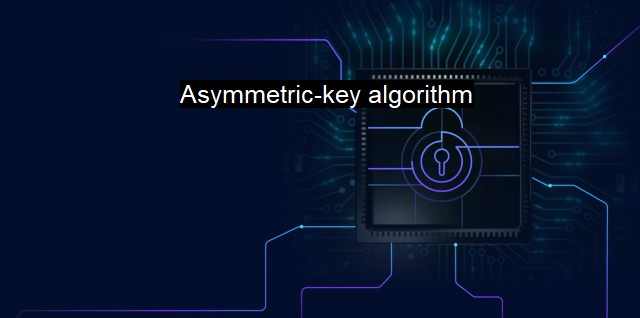What is Asymmetric-key algorithm?
Unlocking Public-Key Cryptography: Understanding the Asymmetric-Key Algorithm for Secure Communication
Various terminologies and concepts significantly contribute to securing networks and data globally. One such concept is the "asymmetric-key algorithm". This term denotes a type of encryption algorithm that utilizes a pair of keys – a private key and a public key – for the encryption and decryption of data. It is a highly sophisticated method for ensuring secure data communication and plays an indispensable role in modern cryptosystems.The private and public keys in an asymmetric key algorithm are mathematically related; while the public key is used for encryption, the corresponding private key is used for decryption. The distinctiveness of this methodology lies in its property that even if the public key is publicly known, the private key cannot be derived from it. Hence, the information remains secure as long as the private key is kept confidential.
Asymmetric-key algorithms play a distinct role in cybersecurity in terms of preserving data integrity, authentication, and providing non-repudiation services. Users encrypt their data using the intended recipient's public key, making the data unreadable to anyone who does not possess the corresponding private key. Not only does this secure one’s data, but also validates the sender’s identity since only the proper individual can decrypt the incoming data. This principle makes asymmetric encryption useful in establishing secure communication lines across untrusted networks like the internet.
These algorithms also impact antivirus solutions profoundly. Malware and other viruses are becoming increasingly complex, often bypassing traditional encryption practices. In this context, asymmetric-key algorithms can provide secure authentication, making it hard for these threats to infiltrate networks or gain access to data. Asymmetric encryption ensures a higher level of security, making it challenging for unauthorized entities to decrypt intercepted data or create phishing attacks.
One widespread asymmetric-key algorithm is RSA (Rivest–Shamir–Adleman). This public-key cryptosystem allows for secure data transmission and even though computation can be extensive, the level of security it provides is unmatched. RSA is primarily deployed where the security of data for transmission is pivotal. The RSA algorithm's capability to hide data from unauthorized access or deducing the private key from the public key makes it a preferred choice for many cybersecurity strategies.
Another variant is the Digital Signature Algorithm (DSA) often used for digital signatures. Digital signatures made using the DSA are relatively smaller in size compared to those created using RSA, making them quicker to process. Aside from these, elliptic-curve cryptography (ECC) is also utilized, particularly in systems with limited computational power, thanks to its comparable security levels with shorter key lengths. Each asymmetric-key algorithm comes with its unique features, applications, and considerations.
Despite the indispensable value of asymmetric key algorithms to cybersecurity, they are not devoid of weaknesses. For starters, encryption and decryption processes in asymmetric encryption are slower compared to symmetric-key algorithms due to the complexity of the math involved. Also, they can be susceptible to attacks if hackers adopt extensive computational measures (like brute force attacks) or if private keys are not adequately secured.
Despite such challenges, asymmetric-key algorithms remain a crucial defence line in modern cybersecurity measures. They not only secure the integrity of sensitive data but are also invaluable for accurate sender and recipient identity verification. As we move forward and continue to develop precision security measures, asymmetric key algorithms will undoubtedly continue to play a vital role in safeguarding data, thus shaping the cybersecurity and antivirus landscape.

Asymmetric-key algorithm FAQs
What is an asymmetric-key algorithm?
An asymmetric-key algorithm is a cryptographic technique that uses a pair of keys (a public key and a private key) to secure the data communication. The public key is known to everyone, whereas the private key is kept secret by the owner of the key pair.How does an asymmetric-key algorithm work?
In an asymmetric-key algorithm, the sender of the message uses the receiver's public key to encrypt the message, which can only be decrypted using the receiver's private key. This ensures that only the intended recipient can read the message, providing a higher level of security compared to symmetric-key algorithms.What are the advantages of using an asymmetric-key algorithm?
One of the main advantages of using an asymmetric-key algorithm is that it provides a higher level of security compared to symmetric-key algorithms since the private key is kept secret by the owner of the key pair. Additionally, it eliminates the need for a secure exchange of keys since the public key can be shared publicly.How is an asymmetric-key algorithm used in cybersecurity and antivirus?
Asymmetric-key algorithms are extensively used in cybersecurity and antivirus software to provide secure communication channels and protect sensitive data from unauthorized access. They are used in secure email communication, digital signatures, and encryption of sensitive data such as passwords and credit card information. Asymmetric-key algorithms are also used in antivirus software to encrypt, decrypt, and authenticate data, ensuring that only legitimate and authorized users have access to the data.| | A | | | B | | | C | | | D | | | E | | | F | | | G | | | H | | | I | | | J | | | K | | | L | | | M | |
| | N | | | O | | | P | | | Q | | | R | | | S | | | T | | | U | | | V | | | W | | | X | | | Y | | | Z | |
| | 1 | | | 2 | | | 3 | | | 4 | | | 7 | | | 8 | | |||||||